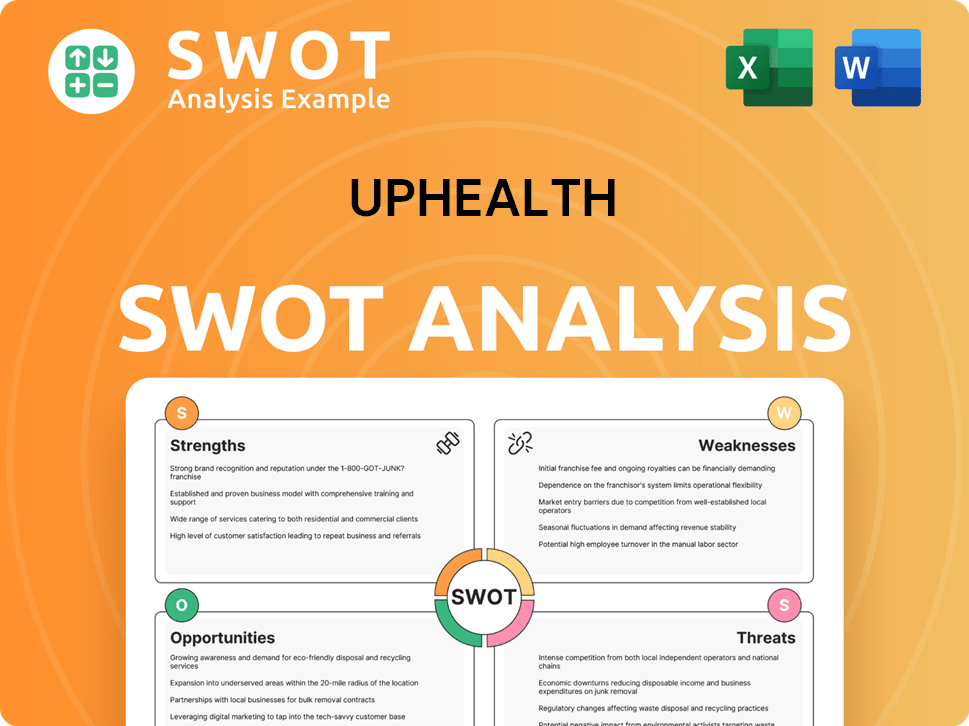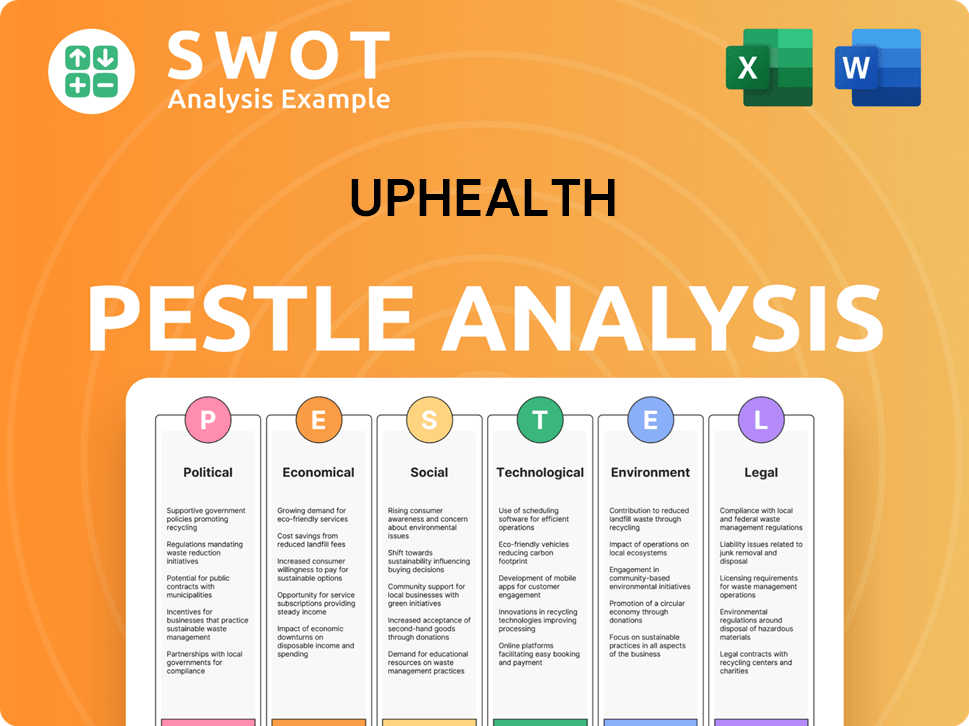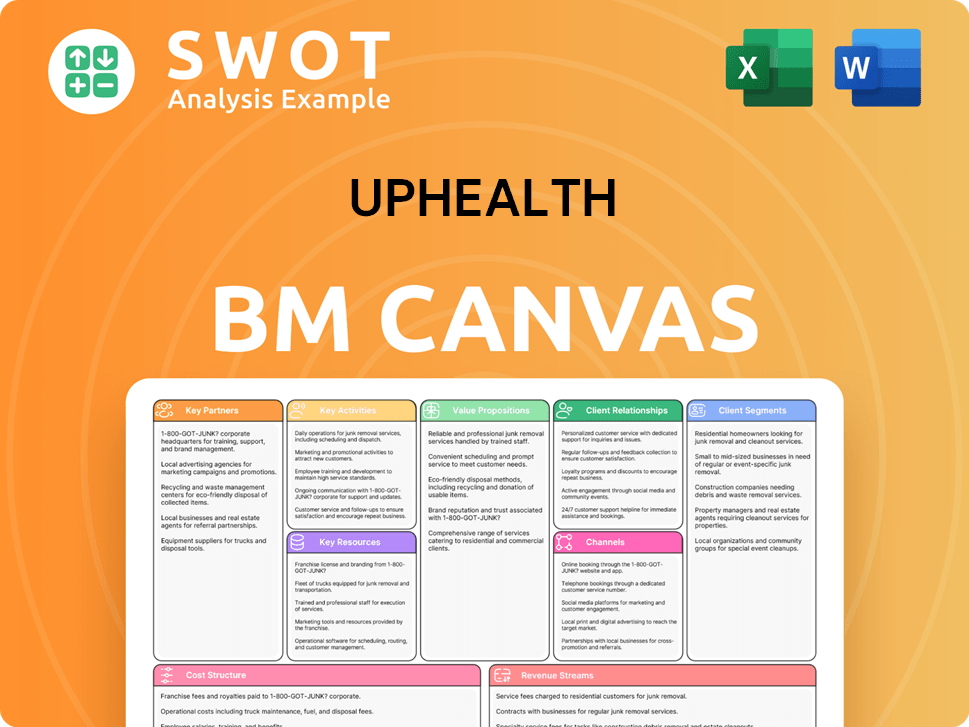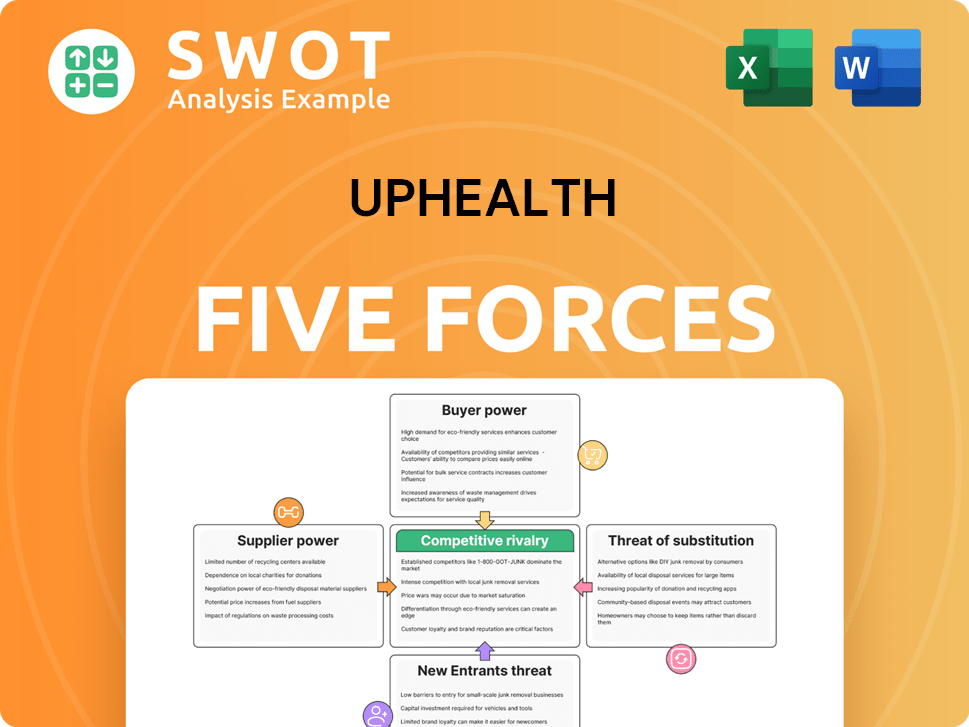UpHealth Bundle
Who Does UpHealth Serve Now?
As UpHealth pivots its focus, understanding its UpHealth SWOT Analysis is crucial for investors and stakeholders. The company's evolution from a broad digital health provider to a specialized behavioral health entity necessitates a deep dive into its current customer demographics and target market. This shift, marked by strategic divestitures, reshapes the market analysis and the very foundation of UpHealth's future.

This exploration will uncover the patient profile UpHealth now serves, including details about UpHealth customer age range, income levels, and geographic locations. We will examine how UpHealth defines its target market, considering factors such as health conditions and the specific needs of its users within the behavioral health sector. This detailed analysis is essential for anyone seeking to understand the current and future trajectory of this evolving healthcare company.
Who Are UpHealth’s Main Customers?
The primary customer segments for UpHealth have significantly evolved, now primarily focusing on behavioral health services through its TTC Healthcare subsidiary. This shift marks a strategic pivot towards a more concentrated market, specifically targeting mental health and substance use disorders. The company serves a diverse clientele within this sector, including healthcare institutions, individual patients, and corporate clients.
The company's target market is largely defined by its payer mix. As of the end of 2023, a substantial portion of TTC Healthcare's revenue, approximately 79%, came from government contracts. The remaining revenue was split between commercial payers (19%) and 'other payers' (2%). This payer mix indicates a strong emphasis on serving individuals whose behavioral health treatments are covered by government programs.
UpHealth operates on a B2B and B2C model. It contracts with health plans, healthcare providers, and community-based organizations (B2B) and delivers care directly to individual patients (B2C). This dual approach allows for a broad reach within the behavioral health sector, catering to various needs and payment structures. This strategic shift was driven by a comprehensive business strategy transformation in 2022, leading to the divestiture of non-core businesses.
While specific demographic breakdowns (age, gender, income) are not publicly available, revenue streams offer insight. The significant reliance on government contracts suggests a demographic leaning towards individuals eligible for government-sponsored healthcare benefits. This Growth Strategy of UpHealth highlights the strategic shift towards a more focused market.
The target market is segmented based on payer type: government, commercial, and other. This segmentation is crucial for understanding the patient profile and tailoring services. The focus on behavioral health, particularly mental health and substance use disorders, further refines the target market. The sale of Cloudbreak Health in March 2024 and Innovations Group in May 2023 illustrates this shift.
Understanding the key demographics of UpHealth's users is essential for market analysis. The reliance on government contracts suggests a significant portion of patients may be from lower-income brackets or those with specific government healthcare coverage. This focus on behavioral health services, particularly mental health and substance use disorders, further defines the patient profile.
- Age range is not specifically detailed, but the services are relevant across various age groups.
- Geographic target market is not explicitly stated, but the company likely operates where government contracts are available.
- Income levels are inferred based on the payer mix, with a significant portion likely falling within the eligibility criteria for government-sponsored healthcare.
- Health conditions primarily include mental health issues and substance use disorders.
UpHealth SWOT Analysis
- Complete SWOT Breakdown
- Fully Customizable
- Editable in Excel & Word
- Professional Formatting
- Investor-Ready Format

What Do UpHealth’s Customers Want?
Understanding the customer needs and preferences of UpHealth is crucial for effective market analysis. The company's primary focus is on behavioral health, particularly through its subsidiary, TTC Healthcare. This specialization allows for a targeted approach to patient care, addressing specific needs within the mental health and substance use disorder sectors.
The target market for UpHealth is driven by the need for accessible and effective treatments. Patients seek solutions that overcome barriers like geographic limitations and scheduling conflicts, which telehealth and digital health platforms address. The decision-making process is influenced by the severity of the condition, the availability of comprehensive care, and the financial accessibility of services.
UpHealth aims to provide a full continuum of care, including detox, residential programs, and outpatient services. This integrated approach helps address the fragmentation of care and the stigma associated with mental health treatment. The company's strategic pivot towards behavioral health demonstrates a commitment to meeting the specific needs of this customer segment.
Customers seek solutions that mitigate barriers to mental health support, such as geographic limitations and scheduling issues. Telehealth services directly address these needs by providing remote access to care.
The need for a full continuum of care, including detox, residential, and outpatient programs, is a key driver. Patients require integrated services to address various aspects of their conditions.
The cost of services significantly influences customer decisions. The ability to afford treatment, including insurance coverage and payment options, is a critical factor.
Customers are motivated by the desire for improved mental well-being and recovery from substance use disorders. The goal is to achieve a better quality of life.
The need for coordinated, data-driven, and personalized care is essential. Patients benefit from integrated services that manage all aspects of their treatment.
UpHealth aims to reduce the stigma associated with seeking mental health treatment. This is achieved by providing accessible and discreet services.
UpHealth addresses several critical needs and pain points for its target market. These include the fragmentation of care, lack of access to specialized services, and the stigma associated with seeking mental health treatment.
- Fragmentation of Care: Patients often struggle with navigating multiple providers and systems. UpHealth's integrated offerings aim to streamline this process.
- Lack of Access: Geographic limitations and a shortage of specialists can hinder access to care. Telehealth and digital platforms help overcome these barriers. In 2024, the Substance Abuse and Mental Health Services Administration (SAMHSA) reported that approximately 48.7 million adults in the U.S. experienced any mental illness.
- Stigma: The social stigma associated with mental health can prevent individuals from seeking help. UpHealth's discreet and accessible services help reduce this barrier.
- Cost and Accessibility: Financial constraints and insurance coverage are significant concerns. UpHealth aims to make services more affordable and accessible.
- Need for Personalized Care: Patients require tailored treatment plans. UpHealth's data-driven approach supports personalized care.
UpHealth PESTLE Analysis
- Covers All 6 PESTLE Categories
- No Research Needed – Save Hours of Work
- Built by Experts, Trusted by Consultants
- Instant Download, Ready to Use
- 100% Editable, Fully Customizable

Where does UpHealth operate?
The geographical market presence of the company has significantly narrowed following strategic restructuring. Initially, it had a global digital health footprint, including operations in Asia with revenues of $3.3 million in Q1 2022. However, the current focus is primarily on the United States.
Specifically, the core behavioral health business, TTC Healthcare, operates facilities in Florida. This indicates a concentrated market share and brand recognition within this specific region for behavioral health services. The company’s strategic withdrawals from other ventures underscore this sharpened geographic focus.
The geographic distribution of sales for the current operations is predominantly within the Americas, with revenues of $42.1 million in Q1 2023. This reflects the company's current strategic emphasis on the U.S. behavioral health market. The Marketing Strategy of UpHealth has adapted to meet the specific regulatory and patient needs within the American healthcare landscape, particularly in Florida.
The company's primary market is now the United States, with a strong emphasis on the behavioral health sector. This shift represents a significant change from its earlier global operations.
TTC Healthcare operates facilities in Florida, with 159 beds across four facilities as of the end of 2023. This concentration highlights a specific geographic target.
The majority of the company's revenue, $42.1 million in Q1 2023, comes from the Americas. This demonstrates the importance of the U.S. market.
The sale of Cloudbreak Health and Innovations Group, along with the deconsolidation of subsidiaries like Thrasys and BHS (in bankruptcy), further narrowed the geographic scope.
UpHealth Business Model Canvas
- Complete 9-Block Business Model Canvas
- Effortlessly Communicate Your Business Strategy
- Investor-Ready BMC Format
- 100% Editable and Customizable
- Clear and Structured Layout

How Does UpHealth Win & Keep Customers?
The customer acquisition and retention strategies of the company, particularly within its behavioral health services, are centered on providing comprehensive, evidence-based treatments. Their primary customer base includes healthcare institutions, individual patients, and corporate clients. The company's reliance on government contracts, representing 79% of its revenue in 2023, indicates a strong emphasis on partnerships with government-funded programs for acquiring customers. This approach is crucial for understanding the UpHealth target market and refining its service offerings.
While specific marketing channels for the company are not extensively detailed in recent public documents, the nature of behavioral health services suggests a combination of direct outreach to healthcare providers, community-based organizations, and patient referrals. The emphasis on 'evidence-based treatments' serves as a key differentiator for attracting and retaining clients, highlighting the quality and effectiveness of care provided. Understanding the patient profile is critical for effective market analysis.
For retention, the full continuum of care offered—from detox and residential programs to outpatient and telehealth services—is crucial. This supports continuity of care and addresses varying patient needs, fostering loyalty. The role of customer data and CRM systems would be vital in managing patient journeys, personalizing experiences, and optimizing care coordination, although specific details about their implementation are not publicly available. Changes in strategy over time have primarily been driven by the company's overall restructuring, leading to a singular focus on the profitable TTC Healthcare business to enhance financial performance and unlock value for stakeholders. This strategic simplification aims to improve customer loyalty by concentrating resources on a core, high-quality service offering.
The company likely employs several strategies to acquire customers, including direct outreach to healthcare providers and community organizations. Partnerships with government-funded programs are also a significant avenue for customer acquisition, given the substantial revenue generated from government contracts. The focus on evidence-based treatments is a key differentiator, attracting clients seeking quality care.
- Direct outreach to healthcare providers and community-based organizations.
- Partnerships with government-funded programs.
- Emphasis on evidence-based treatments and services.
- Referrals from existing patients and healthcare professionals.
UpHealth Porter's Five Forces Analysis
- Covers All 5 Competitive Forces in Detail
- Structured for Consultants, Students, and Founders
- 100% Editable in Microsoft Word & Excel
- Instant Digital Download – Use Immediately
- Compatible with Mac & PC – Fully Unlocked

Related Blogs
- What are Mission Vision & Core Values of UpHealth Company?
- What is Competitive Landscape of UpHealth Company?
- What is Growth Strategy and Future Prospects of UpHealth Company?
- How Does UpHealth Company Work?
- What is Sales and Marketing Strategy of UpHealth Company?
- What is Brief History of UpHealth Company?
- Who Owns UpHealth Company?
Disclaimer
All information, articles, and product details provided on this website are for general informational and educational purposes only. We do not claim any ownership over, nor do we intend to infringe upon, any trademarks, copyrights, logos, brand names, or other intellectual property mentioned or depicted on this site. Such intellectual property remains the property of its respective owners, and any references here are made solely for identification or informational purposes, without implying any affiliation, endorsement, or partnership.
We make no representations or warranties, express or implied, regarding the accuracy, completeness, or suitability of any content or products presented. Nothing on this website should be construed as legal, tax, investment, financial, medical, or other professional advice. In addition, no part of this site—including articles or product references—constitutes a solicitation, recommendation, endorsement, advertisement, or offer to buy or sell any securities, franchises, or other financial instruments, particularly in jurisdictions where such activity would be unlawful.
All content is of a general nature and may not address the specific circumstances of any individual or entity. It is not a substitute for professional advice or services. Any actions you take based on the information provided here are strictly at your own risk. You accept full responsibility for any decisions or outcomes arising from your use of this website and agree to release us from any liability in connection with your use of, or reliance upon, the content or products found herein.